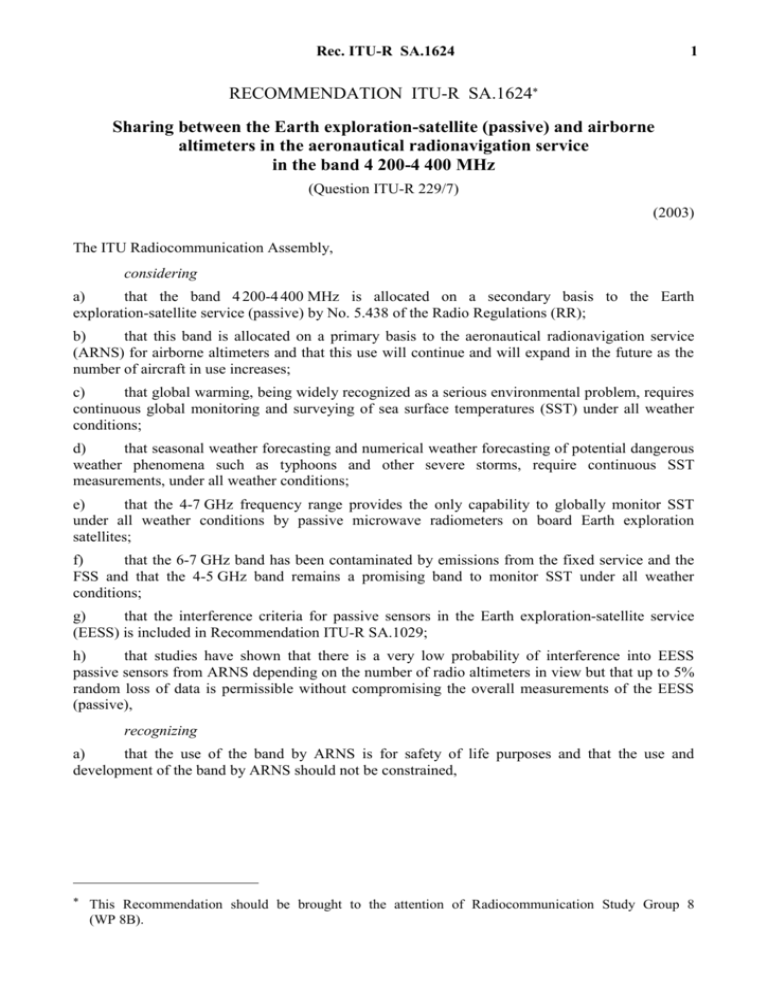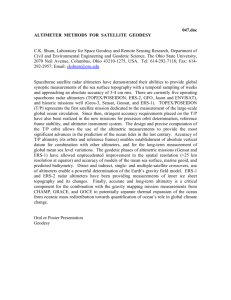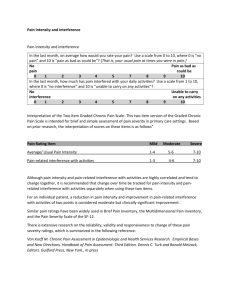Word - ITU
advertisement

Rec. ITU-R SA.1624 1 RECOMMENDATION ITU-R SA.1624* Sharing between the Earth exploration-satellite (passive) and airborne altimeters in the aeronautical radionavigation service in the band 4 200-4 400 MHz (Question ITU-R 229/7) (2003) The ITU Radiocommunication Assembly, considering a) that the band 4 200-4 400 MHz is allocated on a secondary basis to the Earth exploration-satellite service (passive) by No. 5.438 of the Radio Regulations (RR); b) that this band is allocated on a primary basis to the aeronautical radionavigation service (ARNS) for airborne altimeters and that this use will continue and will expand in the future as the number of aircraft in use increases; c) that global warming, being widely recognized as a serious environmental problem, requires continuous global monitoring and surveying of sea surface temperatures (SST) under all weather conditions; d) that seasonal weather forecasting and numerical weather forecasting of potential dangerous weather phenomena such as typhoons and other severe storms, require continuous SST measurements, under all weather conditions; e) that the 4-7 GHz frequency range provides the only capability to globally monitor SST under all weather conditions by passive microwave radiometers on board Earth exploration satellites; f) that the 6-7 GHz band has been contaminated by emissions from the fixed service and the FSS and that the 4-5 GHz band remains a promising band to monitor SST under all weather conditions; g) that the interference criteria for passive sensors in the Earth exploration-satellite service (EESS) is included in Recommendation ITU-R SA.1029; h) that studies have shown that there is a very low probability of interference into EESS passive sensors from ARNS depending on the number of radio altimeters in view but that up to 5% random loss of data is permissible without compromising the overall measurements of the EESS (passive), recognizing a) that the use of the band by ARNS is for safety of life purposes and that the use and development of the band by ARNS should not be constrained, * This Recommendation should be brought to the attention of Radiocommunication Study Group 8 (WP 8B). 2 Rec. ITU-R SA.1624 recommends 1 that sharing between passive sensors in the EESS, used for monitoring SST, and airborne radio altimeters in the ARNS is feasible in the 4 200-4 400 MHz band without constraints on the radio altimeters based on characteristics and the sharing study presented in Annex 1, taking into account considering h) and recognizing a); 2 that passive sensors designed to operate in this band should use antennas with a minimum pointing angle of 35° with respect to nadir to reduce any potential of interference from airborne altimeters. Annex 1 Potential for sharing around 4 300 MHz between radio altimeters and space-based sensors of the EESS (passive) 1 Introduction Global warming is one of the most serious environmental problems for the planet Earth. The parameter known as SST is a useful indicator of global warming. It is very important to be able to monitor the SST continuously to clarify and to better understand the mechanism of global warming. Only spaceborne passive microwave radiometers in orbit on Earth exploration satellites can monitor the whole Earth SST on a continuing basis. To observe the SST, the 4 200-4 400 MHz band is important from a scientific point of view. Since the EESS is allocated as secondary service in this band in RR No. 5.438 for passive sensing, it is desirable to upgrade the allocation to the primary status in the Table of Frequency Allocations to protect the future observations required in this band. Aircraft radio altimeters which operate in the 4 200-4 400 MHz band are an integral part of aviation instrumentation. These instruments are widely utilized for determining the altitude of aircraft in flight and need to be protected from any possible interference due to the obvious safety of life aspects of their usage. Obviously, passive sensors cannot cause any interference into the radio altimeters since they do not emit any radio-frequency energy in the band. Possible interference from the radio altimeters into the passive sensors needs to be determined. This Annex describes the potential for sharing the 4 200-4 400 MHz band with the existing primary allocated service, radio altimeters in the ARNS. 2 Allocation of the 4 200-4 400 MHz band The band 4 200-4 400 MHz is currently allocated to the ARNS on a primary worldwide basis. RR No. 5.438 notes specifically that this band is reserved exclusively for radio altimeters installed on board aircraft and for the associated transponders on the ground. The provision notes further that this band may be used by the EESS (passive) on a secondary basis and with no protection from radio altimeters. Rec. ITU-R SA.1624 3 Additional provisions permit all or part of this band to be used by the fixed service on a secondary basis in some countries, and by the standard frequency and time-satellite service. 3 System characteristics used in the analysis The following characteristics of a typical passive sensor operating in the 4 200-4 400 MHz band are based on the development of a mechanical scanning total power radiometer that will be used for sensing land, ocean and atmospheric characteristics. The following characteristics are based on a typical advanced microwave scanning radiometer: TABLE 1 Characteristics of a microwave radiometer Parameter Value Frequency band (MHz) 4 200-4 400 Sensor bandwidth (MHz) 200 Orbit Circular polar orbit, altitude of 800 km Antenna type Conical scanning, nadir pointing Incident angle (degrees) 55 with respect to nadir Scan angle (degrees) 60 Antenna size (m) 1.6 Antenna beamwidth (degrees) 2.9 Main beam gain (dBi) 35 Side-lobe gain (dBi) 15 Permissable interference (dB(W/200 MHz)) 158 (Recommendation ITU-R SA.1029) System characteristics of the radio altimeters used in the analysis are taken from various input documents to the ITU-R on this topic. TABLE 2 Characteristics of altimeters in the ARNS Parameter Value Frequency (MHz) Transmitter power (CW) (dBW) 4 200-4 400 Transmitter power (pulse) (dBW) 1 200 18 200 Patch antenna 10 70 Transmitter power (W) Pulse repetition frequency (kHz) Pulse width (ns) Antenna type Antenna gain (dBi) Antenna beamwidth (degrees) Antenna back-lobe level (dBi) Shielding effect (dB) 2 30 (without platform) > 5 4 4 Rec. ITU-R SA.1624 Interference analysis Figure 1 depicts the typical altimeter/radiometer interference geometry. Considering that the altimeter antenna is nadir-pointing and the radiometer antenna is forward-looking (47° with respect to nadir), interference into the main beam of the radiometer antenna can only occur via back-lobe emissions from the altimeter antenna and by diffused reflections (scattering). FIGURE 1 Typical altimeter/radiometer interference geometry Forward looking sensor (orbital altitude) Sensor Altitude = 800 km 47° 47° 15° Main beam axis of sensor antenna Earth R = 6 378 km 1/2 Maximum altitude for aircraft (assumed) 3 dB beamwidth 70° 3 dB 3 dB beamwidth 70° Altimeter Altitude = 1624-01 Interference resulting from the back-lobe emissions of a single altimeter into a passive sensor (radiometer) is shown in Table 3. For interference into the main beam of the sensor antenna, it was assumed that the aircraft with an active radio altimeter was crossing the perpendicular to the path of the sensor in orbit which is the worst-case geometry and thus the shortest range for calculating interference. With respect to received interference power due to reflections, calculations show that altimeters would need to have an altitude of 50 m or less for reflections to have an effective contribution to the received interference power into the main beam of a radiometer shown in Table 3. Although the altimeters are always transmitting when the aircraft has power and are used during take-off and/or landing, any reflected interference energy would be of negligible duration and would have no effect on the sensor. From Table 3 we see that a single altimeter located within the main beam of a radiometer using a 35° pointing angle with respect to nadir provides a margin of 8 dB. This implies that at least six such altimeters would have to be located within the main beam of a radiometer to cause any noticeable interference to the radiometer. Similarly, a single altimeter located within the main beam of a radiometer using a 55° pointing angle with respect to nadir provides a margin of 12 dB. This implies that at least 16 such altimeters would have to be located within the main beam of a radiometer to cause any noticeable interference to the radiometer. Rec. ITU-R SA.1624 5 TABLE 3 Interference from a single altimeter into a radiometer in the band 4.2-4.4 GHz Parameter Forward-looking sensor Radiometer altitude (km) 800 Altimeter location with respect to sensor Nadir Main beam Main beam Sensor antenna pointing angle from nadir (degrees) Any 35 55 1.0 Altimeter transmit power (dBW) Altimeter antenna gain (dBi) 30 (back lobe) Aircraft shielding effect (dB) 5 (minimum) Range (km) Free space loss (dB) Radiometer antenna gain (dBi) Received interference power (dBW) 800 1 009 1 646 163 165 169 15 35 35 214 166 170 158 Permissible interference level (dB(W/200 MHz)) Margin (dB) 56 8 12 It should be noted that smaller aircraft use only one altimeter while much larger aircraft use as many as three altimeters. Since these multiple altimeters are not synchronized, it is possible their pulses may coincide leading to higher power levels from a single aircraft. Conversely, larger aircraft will have a larger area and therefore provide more shielding attenuation than would a smaller aircraft. Therefore, the additional interference caused by multiple altimeters on large aircraft is likely to be negligible. Frequently used air corridors and areas in and around airports are regions where the probability is high that multiple aircraft will be located within the main beam of the radiometer. The forwardlooking radiometer in this analysis with a beamwidth of 1.8° will provide an oval-shaped footprint with dimensions on the order of 16 miles wide and 24 miles long. In flight, typical horizontal aircraft separation is on the order of 5 miles, separation distances on approach to landing are shown in Fig. 2. Vertical separation is on the order of 2 000 feet – in flight, and much less on approach to airports. Depending on terrain, aircraft fly as low as 2 000 feet and up to about 36 000 feet. Many airports use two or more landing strips simultaneously and may on average have six aircraft lined up in the approach zone and four aircraft in the downwind zone per landing strip. Additionally, in some areas of densely used airspace, there may be more than one airport within the footprint of the passive sensor. Airports experience a number of periods during the day during which air traffic increases – peaks and valleys depict air traffic patterns. Hours of operation are nearly 24 with an increase in the number of freight carriers during the late night/early morning hours. Given all of these facts, it is still likely that there may be as many as six simultaneously operating radio altimeters in the main beam of the sensor in the immediate vicinity of most airports. 6 Rec. ITU-R SA.1624 FIGURE 2 Typical separation distances during landing Downwind area aircraft separation ~3 miles ~11 to 13 miles Aircraft separation ~3 miles Landing strip 5 to 7 miles Aircraft separation ~2.5 miles 1624-02 The passive sensors using this band would be doing so to observe the SST parameter over the oceans. The oceans occupy about 3.35 × 108 km2 of area. There are 377 412 km of oceanic coastlines in the world. If those of the Arctic and Southern (Antarctic) Oceans are discarded as being without airports, that leaves 265 497 km of viable coastline for airports. Even if every kilometre of coastline contained an airport that caused interference to the passive sensor, this would still be about 0.08% of the service area of the sensor. That is, even if every coastal airport in the world interfered with the passive sensor, this would still not violate the data availability criteria of the sensor for the 4 200-4 400 MHz band. 5 Conclusion Considering that the altimeter antenna is nadir-pointing and the radiometer antenna is forward-looking (normally pointing at an angle of 35° or more with respect to nadir), interference into the main beam of the radiometer antenna can only occur via back-lobe emissions from the altimeter antenna and by diffused reflections (scattering). The analysis shows that in the worst case, it would take six or more aircraft within the main beam of the radiometer to exceed the permissible interference threshold of the sensor. Airports and air corridors are the only regions where there is any possibility that interference will occur if those regions are to be sensed. The probability of there being enough simultaneously operating radio altimeters in the main beam of the sensor in an air corridor to cause any detectable interference is extremely low. With respect to received interference power due to reflections, calculations show that altimeters would need to have an altitude of 50 m or less for reflections to have an effective contribution to the received interference power into the main beam of a radiometer. While altimeters are used during take-off and/or landing, any reflected interference energy would be of negligible duration and would have no effect on the Rec. ITU-R SA.1624 7 sensor. Therefore, passive sensors operating in the 4 200-4 400 MHz band only need to use nadirlooking antennas pointed at 35° or greater with respect to nadir in order to avoid most interference from radio altimeters. It is possible that the passive sensor permissible interference level may be exceeded in the vicinity of airports in ocean coastal regions of the world. However, when considering the size of the oceans being sensed, even if every kilometre of ocean coastline that is populated contained an active airport that caused interference to the sensor, the total amount would be less than the sensor data availability criteria. Given these facts, it is concluded that passive sensors can share the band 4 200-4 400 MHz with radio altimeters operating in the ARNS with no need for protection from the altimeters.






